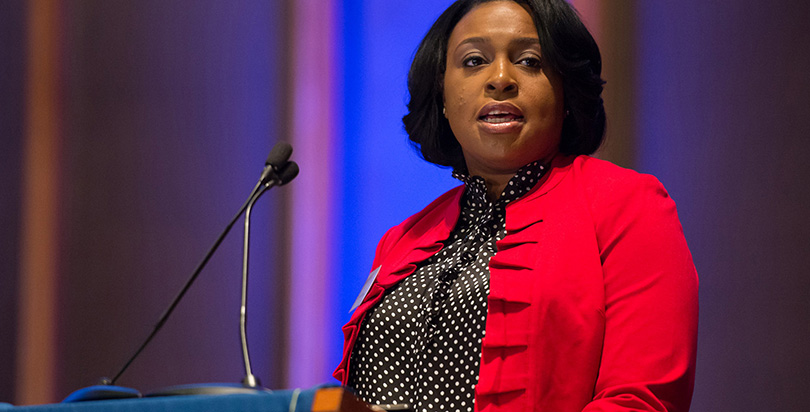Persistently Struggling: Lovely Warren’s Audacious Plan to Save the Distressed Schools of Rochester, NY

Rochester, New York
As the principal recounts the story, one of her seventh-graders was playing basketball outside on the playground as students were dismissed from Enrico Fermi School 17 the day before Christmas break last year.
Another student appeared in the waning light of the December afternoon, an eighth-grader who should not have been at the school because he’d been suspended for fighting. The older student approached the basketball player from behind, put a gun to his back, and marched him toward the school amid a throng of students.
The principal, Caterina Leone-Mannino, dialed 911 but the boy ran off before police arrived. No one was hurt. While the confrontation was captured on security cameras, the weapon was never recovered and no charges were filed, Leone-Mannino said.
Still, she described the incident as a tragedy narrowly averted at a meeting with city and school leaders in February targeting school violence. Among those attending was Rochester Mayor Lovely Warren, who would, two months later, announce an audacious plan to overhaul Rochester’s long-suffering public school system.
Warren would later suggest that this incident, as much as years of dreadful test scores, poor graduation rates, and rampant absenteeism, epitomized the failure of the city’s schools and deepened her resolve to prevent struggling students from slipping through the cracks.
Leone-Mannino explained to the group that the student toting the gun was well-known to social service agencies around the city: At 14, he had already been in and out of jail as he bounced among legal guardians. The summer before, he was witness to a shooting involving at least six people during a party at his foster home, Leone-Mannino said.
Leone-Mannino said that she and her staff fought to get the troubled student into mental health counseling through a local provider for months before he was suspended, but were unable to secure family permission to do so.
“There should have been a protocol in place to make sure he was involved in preventative counseling,” she said. “It's like, how bad do we wait for it to get until we do something? … It's just too common of a story here in Rochester.”
Warren agreed. “Here you have a school, you have a principal that’s trying to move the mark, to do the right thing, within the system,” she told The 74 in a recent interview. “And despite that, you still have these archaic rules and regulations that do not benefit either child. So what happens? What happens? They’re both condemned.”


Rochester, New York skyline (Photo by Brian Stiehler)
Young Lion of the West
The calamity of public education in Rochester is not news within New York State. Once known as “The Young Lion of the West,” the bustling byway along the Erie Canal, it would go on to become a center of abolitionism and women’s suffrage as well as, with the success of Eastman Kodak, the birthplace of personal photography.
Like most cities in the northeast and midwest, Rochester’s economic vibrancy — it has also been home to industry giants like Xerox and Bausch & Lomb, as well as leading universities — was undone over the past half-century by the loss of manufacturing, technological change, and the exodus of white residents.
Today, Rochester has a higher level of child poverty and extreme poverty (families make less than half the poverty rate) than any other city its size in the United States.
The public school system, which educates 28,300 students — 90 percent of whom are non-white and poor — produce the worst test results of any major city in New York State. City-wide proficiency rates on reading and math have floundered in single digits for years. About 30 percent of students are absent for at least 10 days each year; one in five students have disabilities.
The city’s 51 percent graduation rate also trails other cities and is far below the state average of 78 percent.
Many struggling districts can point to inequitable funding as a possible cause of poor performance, but Rochester stands out in spending a lot for dismal results. At $26,392 per student, the city’s allocation is among the highest in New York state, about 65 percent higher than the state average of $17,548, according to a school funding analysis published by National Public Radio.
The Plan
In her April State of the City address at Rochester’s historic Genesee Brewhouse, Warren announced her plan to create a new school district in Rochester for its worst-performing schools.
Warren’s idea built on New York’s recent receivership law, a measure backed by Gov. Andrew Cuomo to accelerate the improvement of chronically low-performing schools by turning them over to an independent manager, or receiver. In July 2015, the state released an initial list of 144 schools across New York that were at risk of takeover by a state-approved receiver in the form of a new leader or non-profit group.
Twenty schools that had fallen short of academic targets for 10 years were deemed “persistently struggling;” the others — “struggling” schools — missed targets for three years.
Superintendents of districts with persistently struggling schools were given additional powers, such as extending the school day and making staffing decisions based on merit. If the schools failed to make “demonstrable” gains after a year, the district risked ceding control over them to an external receiver. The larger group of struggling schools were given two years to improve.
Fourteen schools in Rochester appeared on the original list, but after the state re-ran its numbers with newer data over the winter, a total of 28 could face receivership — about 40 percent of the city’s schools.
In a letter sent to State Education Commissioner MaryEllen Elia the day before publicly announcing the plan at the Genesee Brewhouse, Warren emphasized Rochester’s need for a single district-wide improvement strategy. The state’s approach, she reckoned, could lead to as many as 28 different receivers overseeing 28 separate reforms — “none of which would be required to be coordinated with each other,” she wrote. “This model will not work.”
Warren’s plan envisioned “more immediately and more completely meet[ing] head-on the challenges” of these schools by entering them directly into receivership under a single receiver — selected jointly by Warren and the commissioner — in an independent “Rochester Achievement School District.”
Schools in the new district would have “an unfettered ability” to determine how they should be run, including hiring staff who are “fully aligned with the mission of the converted school” irrespective of seniority. The letter also raised the possibility of schools converting into charters.
There was one big kink in Warren’s plan, however: While the proposed district was similar to widely praised initiatives in Tennessee, New Orleans, and Lawrence, Massachusetts, New York’s new law does not contemplate such an arrangement, according to state officials.
“There is no provision in New York’s receivership law for an entire district to be placed in receivership, or for the creation of an Achievement School District that would operate independent of a school district,” Elia wrote in a response to Warren.
“The ultimate focus of responsibility for the school district’s receivership vision remains vested in the elected school board,” she wrote.
Elia’s “narrow” interpretation of the law hasn’t dissuaded Warren, the lifelong Rochesterian said in an interview. In the coming weeks, she plans to lobby business leaders and state lawmakers to amend the receivership law to include the creation of independent districts in the state turnaround strategy. She has also sought allies on the Board of Regents and in the governor’s office.
The governor’s office did not respond to messages seeking comment on whether Cuomo would support Warren’s proposal for a separate receivership district.
Allen Williams, her closest education advisor and a former school board member, said he and Warren were actually heartened by Elia’s response. Although it appears to be a bit of stretch, Williams contends while the commissioner was “not saying yes, she’s not saying no.”
Models
The use of receivership — at it most basic, appointing an individual or an organization to run one or several schools — has become more widespread in recent years as policymakers search for better ways to improve failing schools. The takeover of Lawrence’s school district in Massachusetts was influential nationally; receiver Jeffrey Riley, previously an executive in Boston’s schools, slashed costs, restructured, and reached a contract with teachers that offset his unusually broad powers with financial incentives and a steep, merit-driven pay ladder — all of which appeared to fuel a moderate rise in test scores and graduation rate, enough to climb past 40 districts it once trailed in achievement.
One reason for Lawrence’s broader appeal was teacher union support, despite frequent conflict, particularly from the leadership of the Lawrence Teachers Union and the national American Federation of Teachers. Unlike in the Recovery School District in New Orleans or the Memphis-based Achievement School District, perhaps the other two most successful large-scale models, Lawrence aimed to repair traditional schools rather than convert them to or supplant them with charters.
(Read The 74: Louisiana Turns the Page: 11 Years After Katrina, New Orleans Schools Set to Return to Local Control)
The mayor’s office commissioned an analysis of receivership and achievement districts nationally, and officials have a draft in hand, but Warren hasn’t waited to argue that elements of those systems could be replicated in Rochester.
“I think that everybody understands that something needs to be done. What that something is is the big elephant in the room,” she said. “My focus and my charge in discussion with all of them (local and state officials) is either we are going to pay on the front end or we are going to pay on the back end,” on mental health issues, incarceration, and social services.
Local political observers expect Warren, a lawyer who formerly served as city council president, to run for re-election in 2017, and the receivership proposal could serve as a centerpiece of her campaign, as education was in 2013. Since her election she has led efforts to fund universal pre-kindergarten, push literacy programs for 3-year-olds, and expand educational after-school opportunities at the city’s recreation centers and libraries.
Board and union united
Not everyone in Rochester’s education world believes Warren is headed in the right direction.
In the weeks since her State of the City announcement, district officials have made clear that she should leave school issues to the professionals.
Van White, the school board president, expressed his skepticism by conjuring a rowboat.
Each sector of the city is responsible for “rowing with their own respective oars”: if people are competing for the same oar, the rowboat will turn in circles, he said.
He encouraged the mayor to focus on expanding job opportunities, clamping down on crime and combating poverty. Rochester is the fifth- poorest city in the country, according to a 2015 report.
“She’s got her hands full,” said White, a former county prosecutor and mayoral advisor known as the city’s “Crime Czar” in the 1990s.
“We’re making progress,” he said, noting that a few Rochester schools are slated to come off the state’s receivership list and pointing to a minor decline in chronic student absenteeism, from 33.4 percent last spring to 32.9 percent this spring.
“We’re not where we need to be, but thank God, we’re not where we were,” he said, although the city’s markers of achievement remain at the bottom of the state.
Williams wants to break that mindset. “From the board’s standpoint and the (teacher union’s) standpoint, only the traditional district schools, along with their collective bargaining agreements and everything else, are capable of delivering a quality education, and that hasn’t happened in the last 30 to 40 years,” he said.
“And for them, any kind of alternative education is just anathema. They view (reformers) as being the absolute enemy and it’ll take a sea change in terms of how they view alternative forms of education.”
Adam Urbanski, the outspoken Rochester Teachers Association President and a fixture in city politics for decades, suggested Warren was out of her depth.
“I don’t think that her willingness to play a role should be rebuffed. However, I am not in support of that particular proposal,” he said. “It’s really nothing more than a back door to mayoral control.”
As for Warren’s plan to take her fight to the legislature, Urbanski said, “We would push back on that, and no, she will not be successful.”
“I’m confident that legislative leaders, particularly those from Rochester, will not support such a request since there’s absolutely no evidence why (we should) believe that she knows something that nobody in the education community knows,” Urbanski said.
He added, by way of a coda, his belief that Williams, the mayor’s advisor, is “clueless about education.”
Complications vs. urgency
Warren has tried to make clear that mayoral control is not on the table, although an unsuccessful 2010 attempt by then-Mayor Robert Duffy to run the schools is far from forgotten.
The administration has emphasized that Warren wants close involvement in how a receivership district is operated but the local school board will continue to govern the rest of Rochester’s schools.
Another uncertainty still waits to be resolved. The board plans to name a new superintendent by the end of June, replacing the interim leader. Whomever it chooses will also serve as the initial school receiver under the state’s template — a position that would not exist if Warren has her way.
The mayor said she shared her views about the qualities she hopes to see in the next superintendent by answering a survey at the board’s invitation earlier this year.
For her and Williams, of course, that’s not enough. They believe the district doesn’t have time to wait and see how a new superintendent will approach the receivership issue.
“How long do we wait until we put something in place to make a difference?” Williams said. “How many students will we grind up, if you will, before we come to the realization that we have to do something and do something now?”
Get stories like these delivered straight to your inbox. Sign up for The 74 Newsletter

;)
